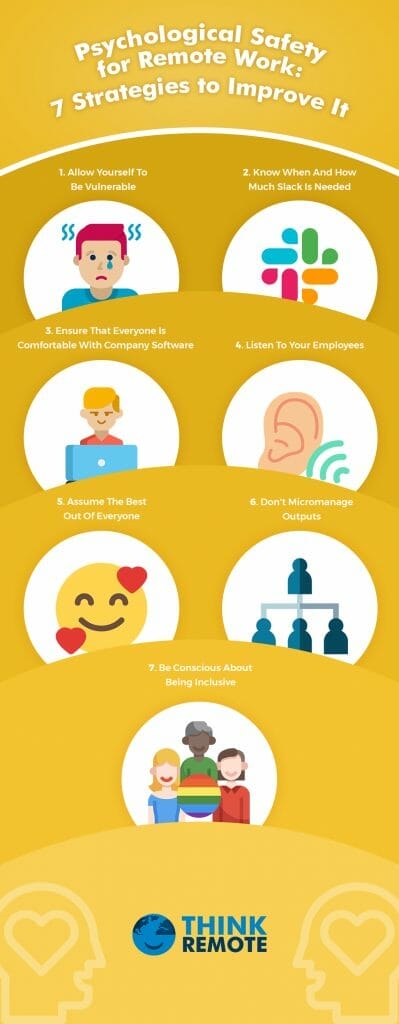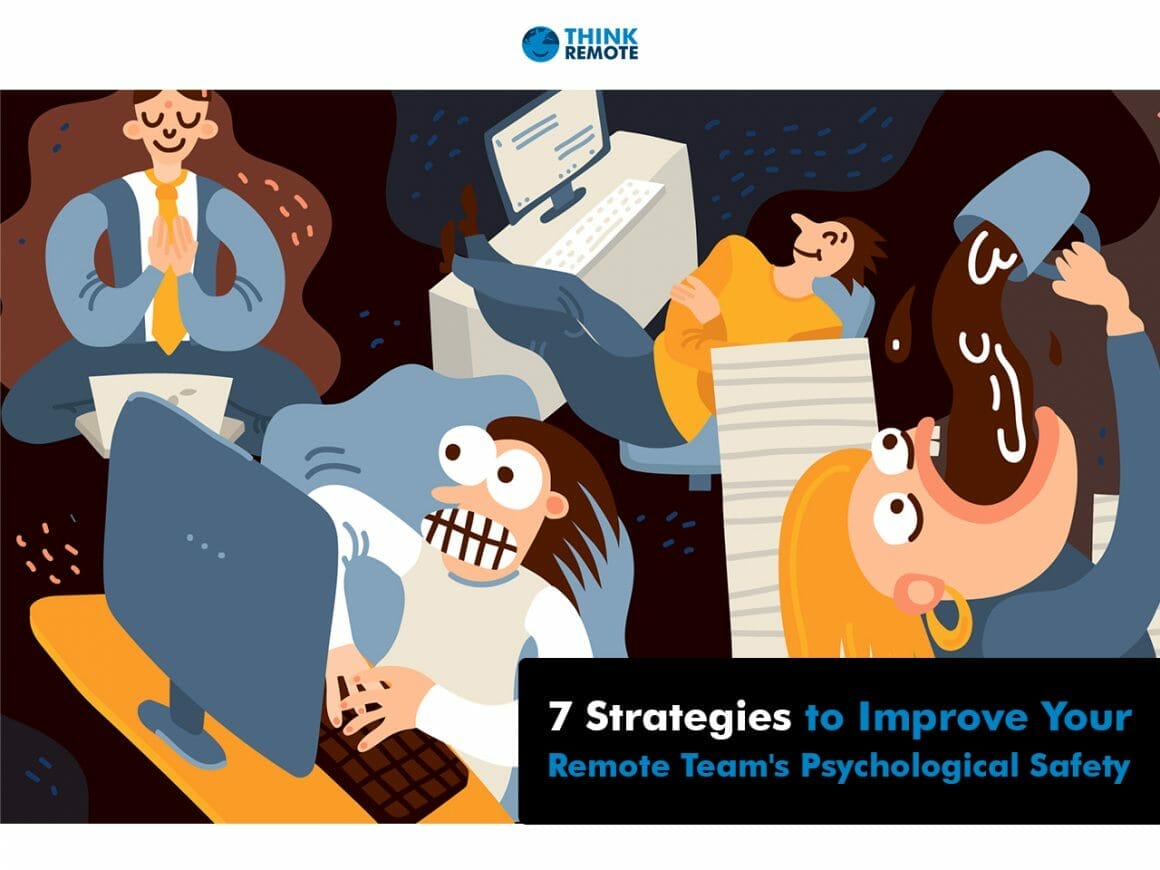Despite the unique challenges of working without the traditional office support systems—such as weak internet connections, the awkward intermingling of work and family life, and cramped home offices—it’s clear that a growing segment of the workforce prefers working remotely over trekking to the office and back every day.
What was initially a stopgap fix is now a lifestyle, not just for traditionally free-ranging positions as writers or programmers, but also for positions that benefit from close working relationships at the office, like customer service and sales.
Why is Psychological Safety Important in a Remote Workplace?
“Psychological safety” is a concept first used in a study conducted by Amy Edmondson at Harvard Business School. It became a buzzword in 2015 when Google conducted a study that revealed psychological safety as one of the five key concepts that predicted successful teams.
Edmondson explains the concept this way:
“Psychological safety describes perceptions of the consequences of taking interpersonal risks in a particular context such as a workplace. A central theme in research on psychological safety—across decades and levels of analysis—is that it facilitates the willing contribution of ideas and actions to a shared enterprise.”
Bear in mind that “psychological safety” and mental health are just a single checkmark in your home office safety checklist to-do’s.
You can think of psychological safety at work as a feeling of being comfortable taking risks or providing ideas without fear of judgment or embarrassment.
Top 5 Indicators That You Have a Toxic Work Environment
- Workers are reluctant to provide input because of the fear that they will be judged.
- Feedback is not constructive and does not provide an opportunity for improvement.
- Employees aren’t sure what is expected of them.
- Team members are more focused on being right or have a “win at all costs” mentality.
- Employees feel excluded from important decisions, discussions, or information sharing within the team
Traditional workplaces should have an easier time spotting the warning signs above. But how can you measure psychological safety in a remote workplace?
Below is a set of psychological safety survey questions adapted from Edmondson that will help you check on your remote team’s mental health.
Respondents rate their level of agreement to the following statements, with “1” indicating strong disagreement and “5” indicating strong agreement.
Their answers to these questions can help get a sense of whether they are thriving or feeling unsafe at work:
- On this team, I understand what is expected of me.
- We value outcomes more than outputs or inputs, and nobody needs to “look busy.”
- If I make a mistake on this team, it is never held against me.
- When something goes wrong, we work as a team to find the systemic cause.
- All members of this team feel able to bring up problems and tough issues.
- Members of this team never reject others for being different and nobody is left out.
- It is safe for me to take a risk on this team.
- It is easy for me to ask other members of this team for help.
- Nobody on this team would deliberately act in a way that undermines my efforts.
- Working with members of this team, my unique skills and talents are valued and utilized.
Psychological Safety for Remote Work: 7 Strategies to Improve It
In this section, we provide seven strategies for companies to offer the best employee experience despite the distance in a remote work environment.
Be sure not to take these strategies as a one-size-fits-all approach, but rather use them as a starting point that you can tailor to your company’s specific needs.

1. Allow Yourself To Be Vulnerable
For many employees, remote working is a chance to escape the office culture of constant meetings, water cooler chats, and hallway interactions.
This doesn’t necessarily have to be a bad thing, but it could unintentionally lead to others feeling unsafe at work.
How do you create a safe emotional space in a remote work environment?
You just can’t command your employees to start opening up, so try taking the lead by allowing yourself to be vulnerable with your team members.
Be open about any fears or concerns running through your mind and provide a safe space for the team members to do the same. This will allow everyone on your team to feel comfortable taking risks without fear of judgment from their teammates—unlocking their potential to turn in excellent work.
2. Know When And How Much Slack Is Needed
Managing a remote team is a lot like managing a traditional team; provide structure and flexibility, but don’t provide too much of either.
To help provide some clarity for your employees without making them feel boxed in, you can use the analogy of “slack” to explain what they should expect from their teammates during working hours.
For example: even if someone is in the middle of something, they should be able to provide you some slack if your question can be easily answered in less than five minutes.
This way, employees know that they’re free to ask for help when needed while still taking full accountability for their work.
3. Ensure That Everyone Is Comfortable With Company Software
There are several project management and communication apps out there—such as Slack, Asana, and Trello—and it can be confusing making heads and tails of them all, especially when there are different levels of expertise across your team. Older employees might require a bit more hand-holding to get up to speed with these tools.
Be willing to make changes as needed to ensure that your team is comfortable working remotely.
If your main work app has a bit of a learning curve, it might be helpful to write an in-house guide for all recruits as well as a dedicated resource person for all their app-related questions.
4. Listen To Your Employees
If an employee doesn’t feel like they can voice their concerns over a particular topic (such as hours or expectations), it could damage their psychological safety at work.
The best way to provide a safe and open environment is to encourage discussion whenever possible, such as setting up regular roundtable discussions with all employees on the same day for each week.
Not all employees will feel comfortable with this, which is why you must provide the right tools to make them feel heard—and taken seriously—when they do speak up.
5. Assume The Best Out Of Everyone
It’s important to set out clear guidelines for communication to avoid the risk of having an emotionally unsafe work environment for your remote workers.
If you don’t provide enough structure for communication in a remote setting—if there are too many opportunities for misunderstandings or hurt feelings—you could be damaging the psychological safety of your team.
Despite its incompatibility with traditional office communications, emojis are a great way to avoid any misunderstandings by shaping how your messages are perceived online.
Using emojis appropriately might not come as naturally for older folks or employees who don’t use them in real life, but it’s a great way of prioritizing emotional safety in the workplace.
A good rule of thumb that works for us is using emojis mainly during lighter moments; for heavier moments, a professional tone is better most of the time.
Firing someone is painful enough for that person—don’t make it worse by tacking on a sad-face emoji at the end.
6. Don’t Micromanage Outputs
In a remote workplace, it is tempting to lean on traditional office metrics to gauge performance, such as requiring employees to punch in and out, setting inflexible deadlines, and measuring outputs quantitatively (e.g. “number of emails sent” or “meetings attended”) instead of focusing on results.
Keep in mind that remote workers might not have the same access to resources or tools, so provide some flexibility when it comes to deadlines and outputs while keeping an eye out for the quality of their work.
An employee who doesn’t meet a deadline might provide a perfectly valid excuse, such as having to care for their child and stay home with them that day.
Don’t assume bad intentions—or laziness—without first speaking to the employee in question. Be open-minded when it comes to adjusting your expectations so you can avoid burning out employees who are already putting 110% into their work.
7. Be Conscious About Being Inclusive
Some people think that supporting diversity just means hiring more women and minorities. While this is, of course, an important step, it’s also crucial that everyone feels like they’re included in the larger conversation—regardless of their gender, ethnicity, or accent.
Others think that having no hate—that you know of, at least—in your heart for, say, LGBTQ+ employees, is enough to promote a safe environment for them in your remote workplace.
However, being “passively inclusive” runs the risk of coming off as “passively exclusive” to your employees. You might “know” that you care about all your team members, but what’s more important is that they know that too.
Learning how to inculcate a company culture of active inclusiveness is a complex topic in and of itself. If you wish to learn more about it, we suggest that you listen to this podcast on how to build a diverse and safe remote work environment to start.






